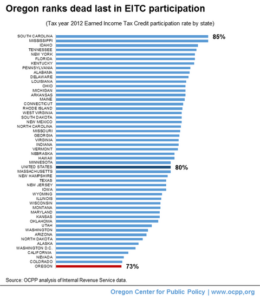Of all working families nationwide, Oregon families are the least likely to claim the federal Earned Income Tax Credit (EITC) — a tax credit that helps low-income households make ends meet. About a quarter of eligible Oregon working families do not claim the federal EITC, collectively leaving about $124 million on the table. Not collecting this money means more economic hardship for many Oregon families, and fewer federal dollars flowing to our state.
To help more Oregon working families claim the EITC, lawmakers should assign a state agency the responsibility of promoting the tax credit.
Oregon Working Families Are Leaving Millions on the Table
Many Oregon working families are not claiming their federal EITC, leaving money on the table. Those funds would both help the families make ends meet and boost Oregon’s economy by enabling families to spend more in local businesses on necessities like groceries, clothes for their kids or a car repair.

In 2012 — the year with most recent data — some 293,000 Oregon households claimed the federal EITC.[1] This amounted to about 73 percent of all Oregonians eligible for the EITC claiming the credit — the lowest EITC participation rate in the country.[2]
About 106,000 eligible Oregon working families failed to claim their credit in 2012. Together, those working families left an estimated $124 million in federal dollars on the table. This is a conservative estimate.[3]
Oregon’s poor performance in 2012 is not an anomaly. For the last five years in which data are available, Oregon ranked no better than 48th among all states and the District of Columbia in terms of its EITC participation rate.
Oregon’s poor performance is even more striking considering that Oregonians have an added incentive to claim the federal EITC: the state’s own EITC. An Oregonian who qualifies for the federal EITC automatically qualifies for the Oregon EITC, which now amounts to 8 percent of the federal tax credit.[4] Oregon working families, however, were less likely to claim the federal EITC than workers in the 24 states without a state EITC.
According to the Internal Revenue Service (IRS), working families in western states are less likely to claim the EITC.[5] The IRS also observes that working families who live in rural areas, are self-employed, do not have a qualifying child, or are not proficient in English are some of those less likely to claim the credit.[6]
The EITC Helps Working Families Make Ends Meet
The EITC is one of the most effective tools for supporting working families and reducing poverty. It does this by helping low- and moderate-income families keep more of the income that they earn through work in the form of a refundable tax credit. For working families, this means being better able to meet the rising costs of child care or catching up on a car payment.
In fact, the EITC is one of the most effective tools for alleviating poverty. When combined with the federal Child Tax Credit, the federal EITC helped lift 129,000 Oregonians, including 65,000 children, out of poverty each year between 2011 and 2013.[7]
The federal EITC adds dollars to the Oregon economy by giving working people more money to spend. Despite Oregon’s poor participation rate, the federal credit injected $574 million into the Oregon economy in 2012.[8]
Oregon Can Do More to Ensure Eligible Working Families Receive Their EITC
Why are Oregon working families so unlikely to claim the federal EITC relative to families in other states? While the answer to this question is not entirely clear, Oregon can and must do better. Many low-income working families and the state as a whole would be better off if more who are eligible would claim the federal tax credit.
To ensure more families claim their EITC, a state agency should be tasked with promoting the credit. Such a responsibility could fall on the Oregon Department of Revenue, which can communicate with taxpayers and identify taxpayers eligible for the credit based on tax return history. Or the responsibility could rest with the state’s economic development agency, Business Oregon, given that the more than $100 million in federal dollars left on the table each year could be spent at local businesses. Or the EITC could be the responsibility of the Department of Human Services, which helps low-income families become self-sufficient.
Ultimately, it is up to the Governor or lawmakers to assign a state agency with the responsibility of promoting working family tax credits. This effort should include not only the federal EITC, but the Oregon Earned Income Credit, the Oregon Working Family Child and Dependent Care Credit, as well. That agency should provide employers, child care providers and others with whom low-income working families interact with clear and concise information about how to claim the EITC.
Unless a state agency is held accountable for maximizing use of the federal EITC, it is unlikely that Oregon’s history of poor performance will improve. Without an official champion, Oregon will continue to leave federal dollars on the table, and low-income working families will continue to struggle more than they need to.
A Note on Methodology
To estimate the total amount of unclaimed EITC dollars, it is important to consider participation rates by the number of dependents in a worker’s household. While it is unclear exactly which workers are less likely to claim their EITC, childless workers are perhaps the least likely because their credits are much smaller. Simply multiplying the estimated number of eligible workers not claiming the credit by the average EITC dollar amount would likely overestimate the total number of unclaimed dollars.
Instead, we use national 2009 EITC participation rates by number of dependents from a Census Bureau working paper as a proxy measure for Oregon’s participation rates for childless workers, workers with one dependent and workers with two or more dependents.[9] Given that Oregon’s overall participation rate is lower than the national average, the estimates derived using these participation rates are likely on the conservative end.
Taking the number of Oregon federal EITC claims by number of dependents in tax year 2012, we divide by the respective participation rate to estimate the total number of workers eligible for the EITC by number of dependents.[10] Using those estimates, we subtract the number of actual claims to derive the estimated number of Oregon childless workers, workers with one dependent and workers with two or more dependents that did not claim the federal EITC.
We then multiply the number of eligible workers not claiming the EITC for each household type by the average EITC amounts for childless workers, workers with one dependent and workers with two or more dependents.[11] We estimate the unclaimed EITC’s amount to be $13.6 million for childless workers, $31.2 million for workers with one dependent and $79 million for workers with two or more dependents. Together, these figures provide a conservative estimate of $124 million in unclaimed federal EITC benefits in Oregon in 2012.
[1] For this fact sheet, unless otherwise noted, all figures are OCPP analysis of Oregon Department of Revenue (DOR) data and Internal Revenue Service (IRS) data. Published IRS data on participation rates include more than 95 percent of all Oregon tax returns claiming the EITC, but are incomplete. To estimate the number of eligible workers not claiming the EITC, we use DOR data of all Oregon tax returns claiming the EITC in tax year 2012 and the IRS’s published participation rate for that year.
[2] OCPP analysis of Internal Revenue Service data.
[3] OCPP analysis of Oregon Department of Revenue and U.S. Census Bureau data. For a detailed methodology, see “A Note on Methodology,” above.
[4] For tax year 2012, the Oregon EITC was 6 percent of the federal EITC.
[5] Dean Plueger, Earned Income Tax Credit Participation Rate for Tax Year 2005, Internal Revenue Service, July 2012, available at https://www.irs.gov/pub/irs-soi/09resconeitcpart.pdf.
[6] Others who may be less likely to claim their EITC include workers who receive certain disability pensions or have children with disabilities, are grandparents raising their grandchildren or, “are recently divorced, unemployed, or experience[d] other changes to their marital, financial, or parental status.” For more, see Internal Revenue Service, About EITC, January 2015, available at http://www.eitc.irs.gov/EITC-Central/abouteitc.
[7] Oregon Fact Sheet: Tax Credits Promote Work and Fight Poverty, Center on Budget and Policy Priorities, September 2015, available at http://apps.cbpp.org/3-5-14tax/?state=OR.
[8] OCPP analysis of Internal Revenue Service data.
[9] Jones, Maggie R., Changes in EITC Eligibility and Participation, 2005—2009, U.S. Census Bureau, Table 7, July 2014, available at https://www.census.gov/srd/carra/Changes_in_EITC_Eligibility_and_Participation_2005-2009.pdf.
[10] Tax year 2012 Oregon federal EITC data by number of dependents emailed by Mark Beilby (DOR) to Tyler Mac Innis (OCPP) on May 27, 2015. Data are for all filers.
[11] Tax year 2012 Oregon federal EITC data by number of dependents emailed by Mark Beilby (DOR) to Tyler Mac Innis (OCPP) on May 27, 2015. Data are for all filers.








